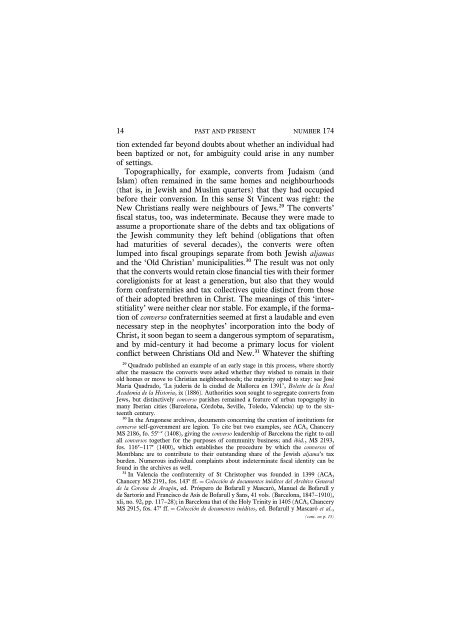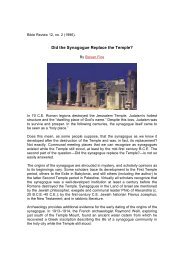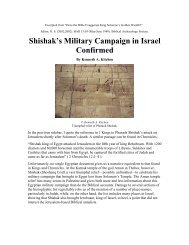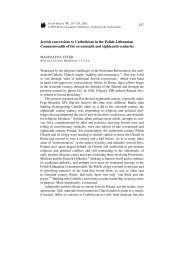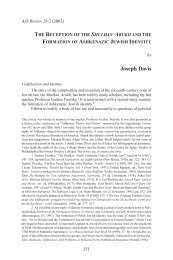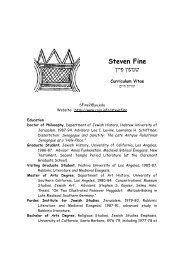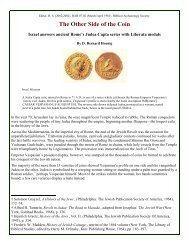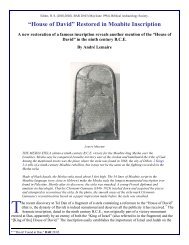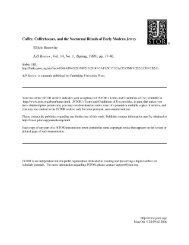jews and christians in fifteenth-century spain
jews and christians in fifteenth-century spain
jews and christians in fifteenth-century spain
You also want an ePaper? Increase the reach of your titles
YUMPU automatically turns print PDFs into web optimized ePapers that Google loves.
14 PAST AND PRESENT NUMBER 174<br />
tion extended far beyond doubts about whether an <strong>in</strong>dividual had<br />
been baptized or not, for ambiguity could arise <strong>in</strong> any number<br />
of sett<strong>in</strong>gs.<br />
Topographically, for example, converts from Judaism (<strong>and</strong><br />
Islam) often rema<strong>in</strong>ed <strong>in</strong> the same homes <strong>and</strong> neighbourhoods<br />
(that is, <strong>in</strong> Jewish <strong>and</strong> Muslim quarters) that they had occupied<br />
before their conversion. In this sense St V<strong>in</strong>cent was right: the<br />
New Christians really were neighbours of Jews.29 The converts’<br />
fiscal status, too, was <strong>in</strong>determ<strong>in</strong>ate. Because they were made to<br />
assume a proportionate share of the debts <strong>and</strong> tax obligations of<br />
the Jewish community they left beh<strong>in</strong>d (obligations that often<br />
had maturities of several decades), the converts were often<br />
lumped <strong>in</strong>to fiscal group<strong>in</strong>gs separate from both Jewish aljamas<br />
<strong>and</strong> the ‘Old Christian’ municipalities.30 The result was not only<br />
that the converts would reta<strong>in</strong> close f<strong>in</strong>ancial ties with their former<br />
coreligionists for at least a generation, but also that they would<br />
form confraternities <strong>and</strong> tax collectives quite dist<strong>in</strong>ct from those<br />
of their adopted brethren <strong>in</strong> Christ. The mean<strong>in</strong>gs of this ‘<strong>in</strong>terstitiality’<br />
were neither clear nor stable. For example, if the formation<br />
of converso confraternities seemed at first a laudable <strong>and</strong> even<br />
necessary step <strong>in</strong> the neophytes’ <strong>in</strong>corporation <strong>in</strong>to the body of<br />
Christ, it soon began to seem a dangerous symptom of separatism,<br />
<strong>and</strong> by mid-<strong>century</strong> it had become a primary locus for violent<br />
conflict between Christians Old <strong>and</strong> New.31 Whatever the shift<strong>in</strong>g<br />
29 Quadrado published an example of an early stage <strong>in</strong> this process, where shortly<br />
after the massacre the converts were asked whether they wished to rema<strong>in</strong> <strong>in</strong> their<br />
old homes or move to Christian neighbourhoods; the majority opted to stay: see José<br />
María Quadrado, ‘La judería de la ciudad de Mallorca en 1391’, Boletín delaReal<br />
Academia de la Historia, ix (1886). Authorities soon sought to segregate converts from<br />
Jews, but dist<strong>in</strong>ctively converso parishes rema<strong>in</strong>ed a feature of urban topography <strong>in</strong><br />
many Iberian cities (Barcelona, Córdoba, Seville, Toledo, Valencia) up to the sixteenth<br />
<strong>century</strong>.<br />
30 In the Aragonese archives, documents concern<strong>in</strong>g the creation of <strong>in</strong>stitutions for<br />
converso self-government are legion. To cite but two examples, see ACA, Chancery<br />
MS 2186, fo. 55r–v (1408), giv<strong>in</strong>g the converso leadership of Barcelona the right to call<br />
all conversos together for the purposes of community bus<strong>in</strong>ess; <strong>and</strong> ibid., MS 2193,<br />
fos. 116v–117r (1400), which establishes the procedure by which the conversos of<br />
Montblanc are to contribute to their outst<strong>and</strong><strong>in</strong>g share of the Jewish aljama’s tax<br />
burden. Numerous <strong>in</strong>dividual compla<strong>in</strong>ts about <strong>in</strong>determ<strong>in</strong>ate fiscal identity can be<br />
found <strong>in</strong> the archives as well.<br />
31 In Valencia the confraternity of St Christopher was founded <strong>in</strong> 1399 (ACA,<br />
Chancery MS 2191, fos. 143v ff.=Colección de documentos <strong>in</strong>éditos del Archivo General<br />
de la Corona de Aragón, ed. Próspero de Bofarull y Mascaró, Manuel de Bofarull y<br />
de Sartorio <strong>and</strong> Francisco de Asís de Bofarull y Sans, 41 vols. (Barcelona, 1847–1910),<br />
xli, no. 92, pp. 117–28); <strong>in</strong> Barcelona that of the Holy Tr<strong>in</strong>ity <strong>in</strong> 1405 (ACA, Chancery<br />
MS 2915, fos. 47r ff.=Colección de documentos <strong>in</strong>éditos, ed. Bofarull y Mascaró et al.,<br />
(cont. on p. 15)


